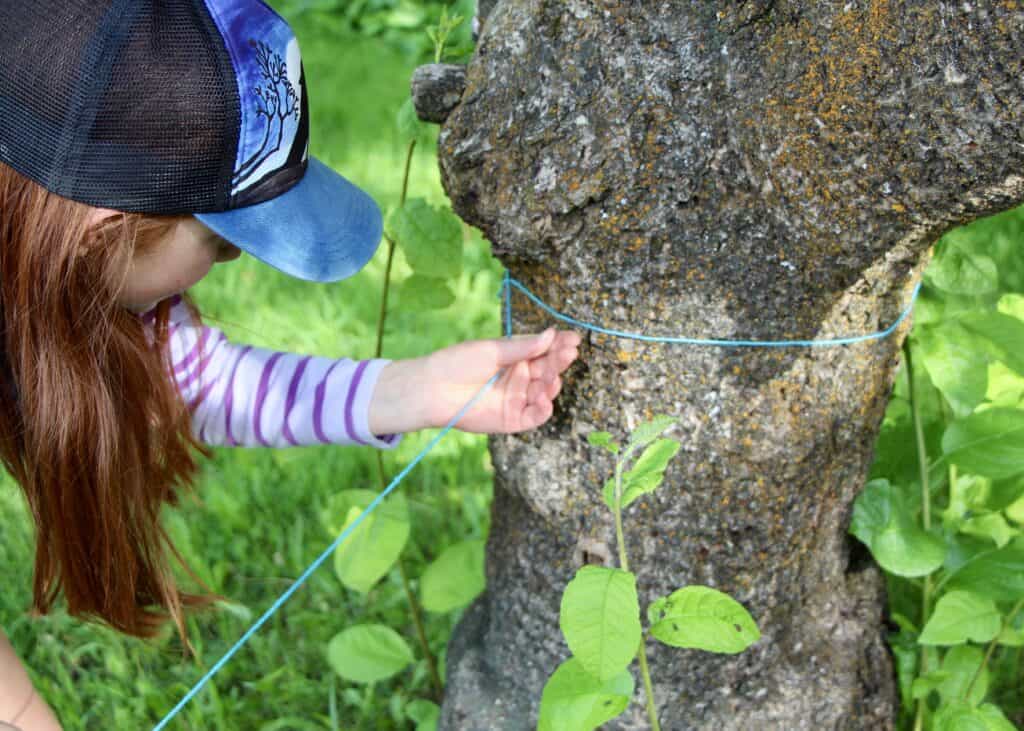Wild Math is an outstanding outdoor curriculum that helps parents (homeschooling and those who just want to boost some learning over breaks) take learning outside.
SUPER SALE! >>>Go here and use code “mathoutside” for 15% off through September 15th, 2020 <<<
It’s summer break. You have a houseful of kids that are tracking in mud, asking for screen time, jumping on the couches, whining for a snack. They’ve just spent somewhere in the neighborhood of 175 days in school, and want to put formal education on the back burner and just enjoy their summer.
Looking for more educational resources? Check out our full list here!
>>> Check out our review of Wild Math Second Grade here and Wild Math Fourth Grade here. <<<

You don’t want to spend your entire summer playing chauffeur, shuttling them from playdates to swim lessons while their math skills do the summer slide, losing the achievement gains they made during the school year. And, you don’t know how to integrate math into their jam-packed summer agenda.
Enter Wild Math.

What IS Wild Math
Wild Math is an engaging, easy to use outdoor math curriculum guide for grades Kindergarten through Fifth-Grade. The guides cover all of the typical math skills taught for that particular grade level, and for each skill, there are many ideas, games, and hands-on learning materials. Check out our review of second grade in particular here.
You’ll be using natural materials like rocks, twigs, and pinecones to learn place value and practice addition and subtraction.
You’ll be making a travel-friendly pocket math kit, perfect for the sidelines of the soccer field, a pause alongside the trail, or the picnic blanket break at the beach.

Getting Started with Wild Math
The edition that my children and I tried, was the Wild Math Guide for First Grade. I have a 6-year-old, and a 9-year-old, and I found that the First Grade Guide works well with a variety of age group or grade levels. This is especially useful when using the curriculum as a summertime program for your children over the school break.
One of the first things we did when using Wild Math, was to gather & make our materials. This in itself was great fun. My kids loved gathering flat rocks to turn into number stones and scouring the forest floor for twigs to make into bundles of 10.
A homemade felt ten-frame is an integral part of the lessons. I used a hemmed scrap of woven fabric & a permanent marker to make the ten-frame as I wanted it to be washable.

Materials & Lessons
When our materials and pocket math kits were ready, we went through the First Grade Wild Math Guide as a family and picked some lessons to try right away in our own backyard. The directions are delightfully easy to follow.
I modified the lessons on occasion to challenge my 9-year-old, as she really wanted to join her younger brother in his Wild Math explorations. My 6-year-old son loved working with the natural materials much more than our standard math items like a traditional ruler, our plastic Cuisenaire rods and unifix cubes.
My 9-year-old loved measuring. We made measuring tools out of yarn, with knots tied at one-foot intervals and a smooth, water-worn stick was transformed into a measuring device with the addition of sharpie markings….a slash for every inch.
The kids ran around the yard measuring every tree, flower stalk, or wiggling worm they could find and writing their measurements down on their clipboard. What a great way to encourage math exploration!

Bring Education Along with you
I really like the portability of Wild Math. It inspired me to bring math into our day in unexpected ways that I hadn’t previously considered.
One very rainy Spring day, after we’d been using the first-grade curriculum for just over a week, we were exploring the botanic garden when my 6-year-old wondered aloud how many stepping stones were in a certain stretch of pathway.
I immediately thought – “what a great time to squeeze some Wild Math into our day”, and suggested he count them as he went. He counted 92, and then went back over it two times to be sure he had the right number.
Then we tried counting backward from 92, changed our starting number ((to meet the 1st-grade math standard of counting to 120 from any number other than zero)), and counted by 2’s.
I challenged my 9-year-old to skip count by 3’s as she went along the pathway, then she challenged herself by subtracting by 3 for every step she took (backward, which led to lots of laughter and some stumbles into the mud).
They both loved it, and I have to say, without having Wild Math as my guide, I would never have thought to use this opportunity to explore numbers together!

Why you should consider Wild Math
Overall, this is a tool I highly recommend for outdoor families, as either a way to keep math momentum going during a school break or as a stand-alone or supplemental math curriculum for homeschooling families.
I love that it brings math to life, and the hands-on nature of the lessons are very appealing to outdoor kids! As for myself, I’m buying the rest of the guides in the series as a summertime math-slide & sanity saver for our family.

Details about the author
Rachel Tidd is the author of Wild Math Curriculum. She and her husband Leo, live with their two boys in a log cabin just outside of Ithaca, NY. She spends her days’ homeschooling, swimming in creeks and lakes, writing, hiking, knitting and driving kids to activities.
Prior to having children, Rachel was an elementary special education teacher.
Pin it:

© 2020, Tales of a Mountain Mama. All rights reserved. Republication, in part or entirety, requires a link back to this original post and permission from the author.
